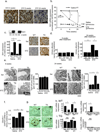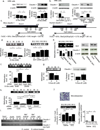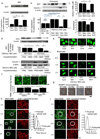Renal tubular Sirt1 attenuates diabetic albuminuria by epigenetically suppressing Claudin-1 overexpression in podocytes
- PMID: 24141423
- PMCID: PMC4041199
- DOI: 10.1038/nm.3363
Renal tubular Sirt1 attenuates diabetic albuminuria by epigenetically suppressing Claudin-1 overexpression in podocytes
Abstract
Sirtuin 1 (Sirt1), a NAD(+)-regulated deacetylase with numerous known positive effects on cellular and whole-body metabolism, is expressed in the renal cortex and medulla. It is known to have protective effects against age-related disease, including diabetes. Here we investigated the protective role of Sirt1 in diabetic renal damage. We found that Sirt1 in proximal tubules (PTs) was downregulated before albuminuria occurred in streptozotocin-induced or obese (db/db) diabetic mice. PT-specific SIRT1 transgenic and Sirt1 knockout mice showed prevention and aggravation of the glomerular changes that occur in diabetes, respectively, and nondiabetic knockout mice exhibited albuminuria, suggesting that Sirt1 in PTs affects glomerular function. Downregulation of Sirt1 and upregulation of the tight junction protein Claudin-1 by SIRT1-mediated epigenetic regulation in podocytes contributed to albuminuria. We did not observe these phenomena in 5/6 nephrectomized mice. We also demonstrated retrograde interplay from PTs to glomeruli using nicotinamide mononucleotide (NMN) from conditioned medium, measurement of the autofluorescence of photoactivatable NMN and injection of fluorescence-labeled NMN. In human subjects with diabetes, the levels of SIRT1 and Claudin-1 were correlated with proteinuria levels. These results suggest that Sirt1 in PTs protects against albuminuria in diabetes by maintaining NMN concentrations around glomeruli, thus influencing podocyte function.
Conflict of interest statement
The authors have declared that no conflict of interest exists.
Figures






Comment in
-
Diabetic nephropathy: Sirt1 attenuates diabetic albuminuria.Nat Rev Nephrol. 2013 Dec;9(12):696. doi: 10.1038/nrneph.2013.228. Epub 2013 Oct 29. Nat Rev Nephrol. 2013. PMID: 24166142 No abstract available.
-
Sirt1-Claudin-1 crosstalk regulates renal function.Nat Med. 2013 Nov;19(11):1371-2. doi: 10.1038/nm.3386. Nat Med. 2013. PMID: 24202384 No abstract available.
References
Publication types
MeSH terms
Substances
Grants and funding
LinkOut - more resources
Full Text Sources
Other Literature Sources
Medical
Molecular Biology Databases
Miscellaneous

